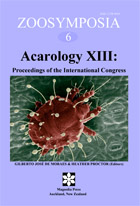Abstract
Acute toxicity of spirotetramat to immatures and its sublethal effects on adult females of two-spotted spider mite, Tetranychus urticae Koch, were investigated in laboratory bioassays, at 27 ± 2°C, 50–80% RH and 16/8 L/D photoperiod.Acute toxicity was tested by successive treatments of eggs, larvae, protonymphs and deutonymphs on bean leaf discs, and mortality was evaluated based on the number of mites reaching the adult stage. Concentration-mortality data were subjected to probit analysis and the following LC50 data were computed: 0.10 mg/l (larvae), 0.17 mg/L (protonymphs) and 0.15 mg/L (deutonymphs). The acaricidal effect after the treatment of eggs was not the result of spirotetramat toxicity to this developmental stage, but rather of its residual activity on hatched larvae (LC50=0.62 mg/L). Sublethal effects were evaluated after the treatment of pre-ovipositing adult females on leaf discs using the concentrations of 2 mg/L, 20 mg/L and 200 mg/L.After 18–20 hours of exposure on treated discs, females showing no visible symptoms of poisoning were transferred to untreated leaf discs and re-transferred to new discs at 48 h intervals over ten days. Based on the number of eggs laid and survival rate of females, gross fecundity and net fecundity were calculated. At the end of the tenth day, the survival rate was 0.72 in untreated and 0.40, 0.27 and 0.05 in females treated at the concentrations mentioned above. Compared with the control mites, gross fecundity was reduced by 9% (2 mg/L), 29% (20 mg/L) and 93% (200 mg/L), while net fecundity decreased by 40%(2 mg/L), 67%(20 mg/L) and 98%(200 mg/L). The results indicate that spirotetramat exerts similar effects on spider mites as do the acaricides spirodiclofen and spiromesifen.

